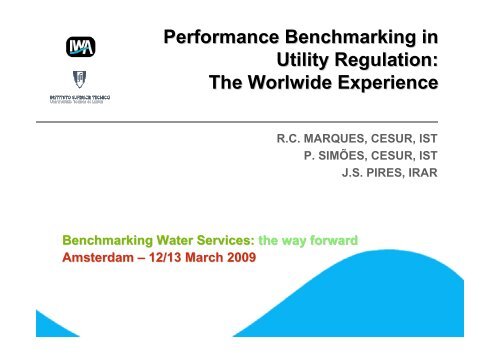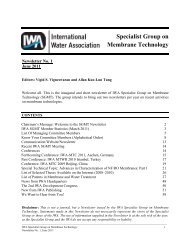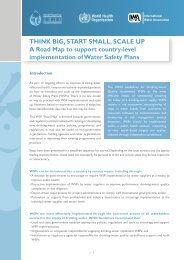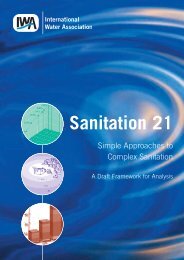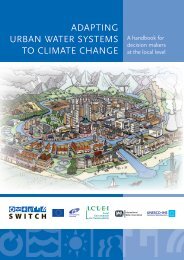Performance Benchmarking in Utility Regulation: The ... - IWA
Performance Benchmarking in Utility Regulation: The ... - IWA
Performance Benchmarking in Utility Regulation: The ... - IWA
You also want an ePaper? Increase the reach of your titles
YUMPU automatically turns print PDFs into web optimized ePapers that Google loves.
<strong>Performance</strong> <strong>Benchmark<strong>in</strong>g</strong> <strong>in</strong><br />
<strong>Utility</strong> <strong>Regulation</strong>:<br />
<strong>The</strong> Worlwide Experience<br />
R.C. MARQUES, CESUR, IST<br />
P. SIMÕES, CESUR, IST<br />
J.S. PIRES, IRAR<br />
<strong>Benchmark<strong>in</strong>g</strong> Water Services: the way forward<br />
Amsterdam – 12/13 March 2009
Agenda<br />
1. Introduction<br />
2. <strong>Benchmark<strong>in</strong>g</strong> application<br />
3. Methodology<br />
4. Results<br />
5. Case-studies<br />
6. Conclusions<br />
2
Introduction<br />
Water and<br />
Wastewater<br />
Services (WWS)<br />
Monopoly<br />
regime<br />
Market failures<br />
Sunk costs, scale and scope<br />
economies, externalities and<br />
public obligations<br />
Reduced <strong>in</strong>centives towards efficiency<br />
and <strong>in</strong>novation<br />
3
Introduction (cont.)<br />
Competitive<br />
environment<br />
Competition by comparison<br />
(Yardstick competition - YC)<br />
<strong>Benchmark<strong>in</strong>g</strong><br />
“<strong>Benchmark<strong>in</strong>g</strong> can be briefly def<strong>in</strong>ed as the process of<br />
seek<strong>in</strong>g excellence through the systematic comparison of<br />
performance measures with reference standards”<br />
(Marques, 2006)<br />
4
Benefits of benchmark<strong>in</strong>g use <strong>in</strong> the regulation<br />
Ma<strong>in</strong><br />
advantages<br />
of<br />
benchmark<strong>in</strong><br />
g use<br />
Strong <strong>in</strong>centives are provided to operators to be efficient and <strong>in</strong>novative, mitigat<strong>in</strong>g the<br />
costs of operation and the capital expenses;<br />
An on-go<strong>in</strong>g pressure is put on the water utilities to improve the quality of service;<br />
A fairer recovery of costs and of the capital <strong>in</strong>vestments is assured;<br />
An <strong>in</strong>crease of transparency and shar<strong>in</strong>g of <strong>in</strong>formation, m<strong>in</strong>imis<strong>in</strong>g its asymmetry<br />
between different stakeholders (specially between regulator and operators).<br />
<strong>Benchmark<strong>in</strong>g</strong><br />
5
<strong>Benchmark<strong>in</strong>g</strong> approaches<br />
YC<br />
X factor computation<br />
price cap formulas<br />
Techniques<br />
• Data Envelopment Analysis (DEA)<br />
• Total Factor Productivity (TFP)<br />
• Ord<strong>in</strong>ary Least Squares (OLS)<br />
• Stochastic Frontier Analysis(SFA)<br />
UK<br />
Colombia<br />
Australia<br />
Portugal<br />
Zambia<br />
Sunsh<strong>in</strong>e<br />
regulation<br />
Efficient<br />
company model<br />
Chile<br />
Peru<br />
6
Methodology<br />
Firstly<br />
Secondly<br />
Questionnaire sent to all regulators and entities with this k<strong>in</strong>d of attributions<br />
Six Chapters<br />
General aspects of the WWS<br />
Scope of regulatory activity<br />
General aspects of the regulatory functions<br />
Economic regulation and public service obligations<br />
Quality of service regulation<br />
Supplementary <strong>in</strong>formation<br />
7
Methodology (cont.)<br />
<strong>The</strong> questionnaire was sent to 279 entities (63 answered it)<br />
136 regulators were found <strong>in</strong> the world<br />
57 countries<br />
25 % of<br />
the world<br />
countries<br />
12 <strong>in</strong> Africa<br />
5 <strong>in</strong> Asia<br />
16 <strong>in</strong> Europe<br />
2 <strong>in</strong> Oceania<br />
22 <strong>in</strong> America<br />
23 % <strong>in</strong><br />
terms of<br />
population<br />
8
Results<br />
9
Results (cont.)<br />
Blue: countries with water<br />
regulation.<br />
Red: countries that<br />
answered the questionnaire.<br />
Green: regulators that apply<br />
benchmark<strong>in</strong>g and<br />
answered the questionnaire.<br />
10
Case-studies<br />
studies<br />
Victoria, Australia<br />
<strong>The</strong> regulator (now<br />
Essential Services<br />
Commission – ESC)<br />
applies sunsh<strong>in</strong>e<br />
regulation here s<strong>in</strong>ce<br />
1994.<br />
Responsible for…<br />
• the quality of service delivered<br />
the quality of the supply<strong>in</strong>g (e.g. water quality and compliance with the norms);<br />
the service reliability (e.g. <strong>in</strong>terruptions, non-revenue water and blockages);<br />
the services availability (e.g. prices, special customers and lack of payment);<br />
the customer service (e.g. call centres, claims and customers’ satisfaction).<br />
• the economic regulation<br />
… <strong>in</strong>creases the transparency and accountability of the WWS.<br />
<strong>The</strong> operators’ progress can be<br />
seen, for example, <strong>in</strong> the evolution<br />
of the <strong>in</strong>dicator water <strong>in</strong>terruptions<br />
(ESC, 2007).<br />
11
Case-studies studies (cont.)<br />
Chile<br />
… efficient operator is imposed<br />
to enable the regulator to<br />
determ<strong>in</strong>e the base costs for<br />
tariffs sett<strong>in</strong>g and it can further<br />
<strong>in</strong>clude the expected<br />
productivity earn<strong>in</strong>gs (X factor)<br />
<strong>in</strong> the price cap formula<br />
Colombia<br />
La Comisión de Regulación de Água<br />
Potable y Saneamiento Basico (CRA)<br />
Sector economic regulation<br />
Def<strong>in</strong>ition of methods and tariff formulas<br />
Regulatory<br />
Process<br />
It uses DEA to compute the efficient adm<strong>in</strong>istrative costs and the efficient OPEX;<br />
Based on a system of price caps def<strong>in</strong>ed for a period of five years which also<br />
<strong>in</strong>cludes a m<strong>in</strong>imum limit of 50 % (price floor).<br />
12
Case-studies studies (cont.)<br />
Zambia<br />
<strong>The</strong> National Water Supply and<br />
Sanitation Council (NWASCO)<br />
guarantee the quality of the services provided<br />
<strong>in</strong>clud<strong>in</strong>g the quality of water.<br />
… is assured by the comparison of a PIs set applied to each operator followed by its<br />
public display (sunsh<strong>in</strong>e regulation).<br />
NWASCO PIs for<br />
water supply and<br />
their weights<br />
(NWASCO, 2007)<br />
Reference values are made available by the regulator for each PI.<br />
NWASCO develops a rank<strong>in</strong>g based on the PIs results, assum<strong>in</strong>g weights for the PIs.<br />
13
Case-studies studies (cont.)<br />
WSS regulation <strong>in</strong> England and Wales is po<strong>in</strong>ted out, <strong>in</strong> the literature, as a<br />
Southern, ,<br />
benchmark for the application of benchmark<strong>in</strong>g <strong>in</strong>Athe regulatory system.<br />
Yorkshire, ,<br />
<strong>The</strong> Water Services <strong>Regulation</strong><br />
Authority(OFWAT)<br />
Regression<br />
DEA<br />
Determ<strong>in</strong>e the efficient costs that are<br />
the basis for the X factors calculation<br />
(<strong>in</strong> the price cap formula)<br />
OPEX<br />
B<br />
C<br />
D<br />
E<br />
Anglian, &<br />
West<br />
Hampshire<br />
Severn , ,<br />
Sutton &<br />
,<br />
Essex &<br />
Suffolk<br />
, Tendr<strong>in</strong>g<br />
Hundred<br />
Dwr Cymru,<br />
Folkestone &<br />
Dover, Mid<br />
Kent<br />
South East<br />
,<br />
Three<br />
Valleys<br />
South<br />
West<br />
E D C B A<br />
CAPEX (ma<strong>in</strong>tenance)<br />
<strong>The</strong> efficient costs are transformed <strong>in</strong>to X factors and become the<br />
goals to be reached by each WWS <strong>in</strong> the follow<strong>in</strong>g regulatory period.<br />
YC (Sunsh<strong>in</strong>e regulation)<br />
A – Most efficient;<br />
B – Over average;<br />
C – Average;<br />
D – Below average;<br />
E – Less efficient<br />
Quality of<br />
service<br />
Overall <strong>Performance</strong> Assessment, measured through a compilation of 9 PIs;<br />
International benchmark<strong>in</strong>g studies, compris<strong>in</strong>g a set of PIs for several<br />
utilities compris<strong>in</strong>g different countries (Scotland, Northern Ireland, EUA,<br />
Canada, Scand<strong>in</strong>avia, the Netherlands, Portugal and Australia).<br />
14
Case-studies studies (cont.)<br />
Italy<br />
WWS are regulated by an authority created <strong>in</strong> 1994,<br />
the (Comitato per la Vigilanza sull'uso delle Risorse<br />
Idriche - COVIRI)<br />
… widelly <strong>in</strong>fluenced by the success of OFWAT<br />
regulatory system…<br />
… COVIRI regulatory method based on<br />
benchmark<strong>in</strong>g uses parametric benchmark<strong>in</strong>g<br />
techniques to estimate the factor X.<br />
COVIRI computes<br />
a set of 55 PIs of<br />
the WWS which<br />
are published <strong>in</strong><br />
an annual report.<br />
19 technical <strong>in</strong>dicators;<br />
18 management <strong>in</strong>dicators;<br />
18 economical-f<strong>in</strong>ancial <strong>in</strong>dicators.<br />
15
Case-studies studies (cont.)<br />
Portugal<br />
Belgium<br />
Waloon region the regulatory<br />
authority (Comité de Contrôle<br />
de l’Eau - CCE)<br />
Quality of service;<br />
Catchments protection;<br />
Management and<br />
susta<strong>in</strong>ability of assets;<br />
Pric<strong>in</strong>g and management;<br />
Coverage and solidarity;<br />
User satisfaction and<br />
communication.<br />
16
Conclusions<br />
<strong>Benchmark<strong>in</strong>g</strong>…<br />
… creates a competitive environment;<br />
… creates strong <strong>in</strong>centives towards efficiency and <strong>in</strong>ovation;<br />
… promotes the efficiency with regard to capital expenses;<br />
17
Conclusions (cont.)<br />
<strong>Benchmark<strong>in</strong>g</strong>…<br />
… assures the “fair” recovery of costs and a “fair” return of the<br />
capital <strong>in</strong>vested;<br />
… <strong>in</strong>creases the <strong>in</strong>formation shar<strong>in</strong>g and transparency;<br />
… has enormous potentialities <strong>in</strong> the supervision of the levels of<br />
quality of service and <strong>in</strong> the sett<strong>in</strong>g of prices and tariffs.<br />
18
Thank you for your attention !<br />
Rui Cunha Marques – rcmar@civil.ist.utl.pt<br />
Pedro Simões – psimoes@civil.ist.utl.pt<br />
Joao Pires – joao.pires@irar.pt<br />
19


